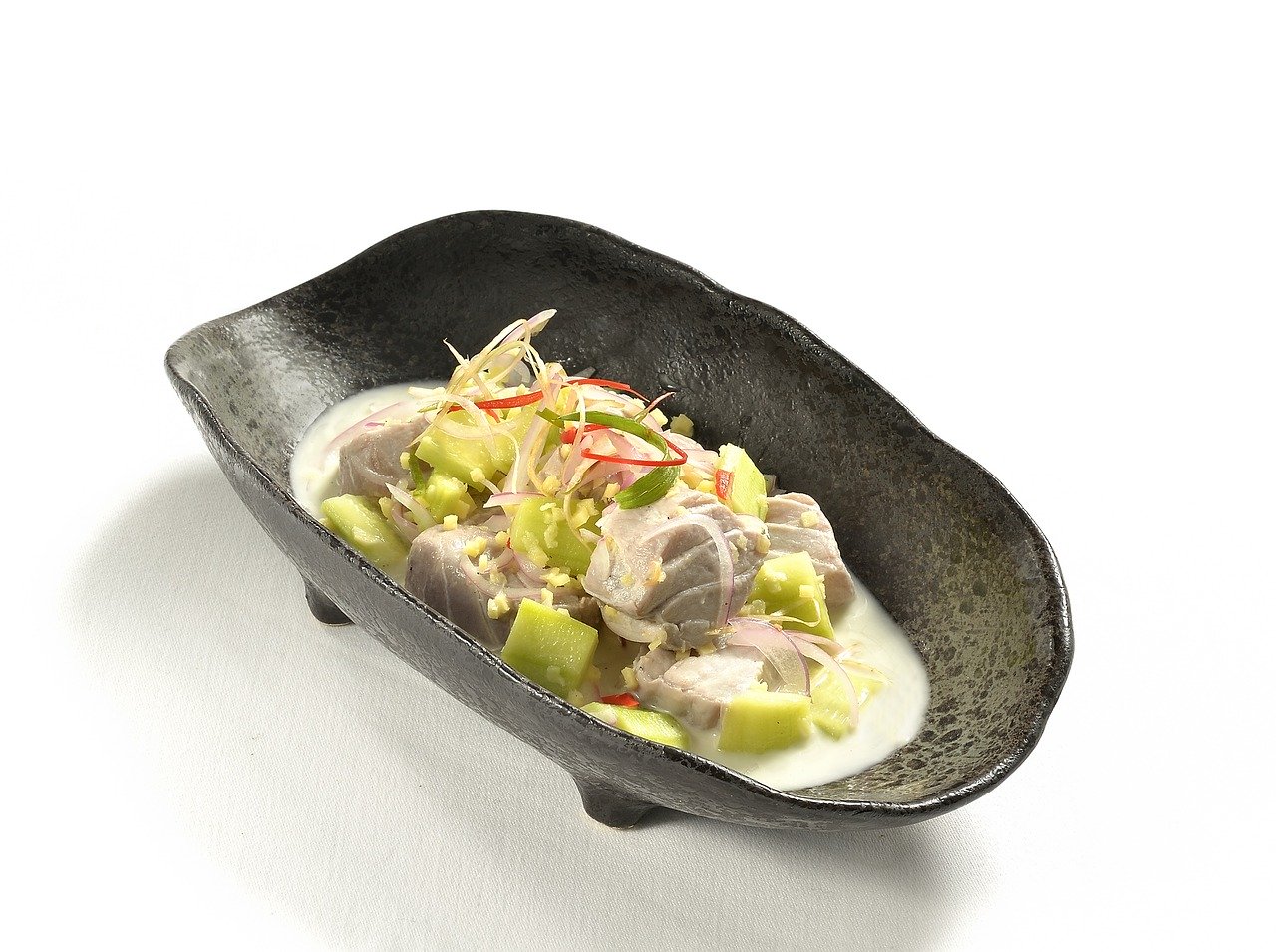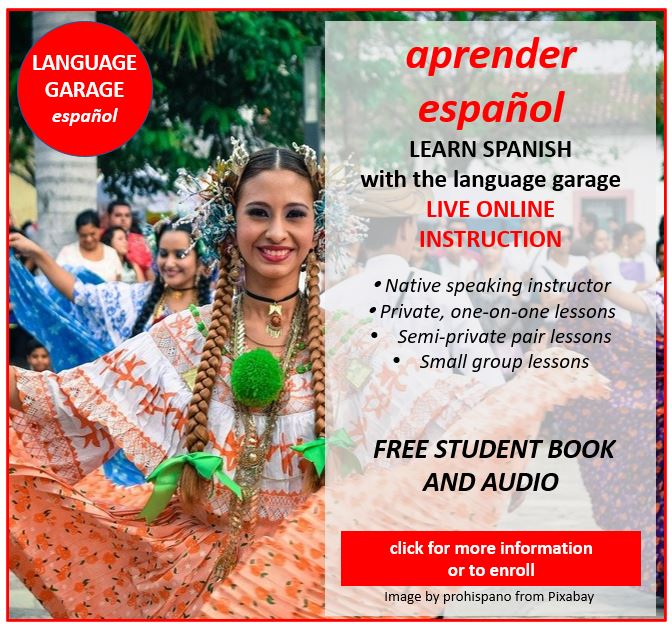If you’re learning Spanish, la comida food is one of the things you’ll probably need to – or at least want to – talk about. So in this post, let’s dig in to some vocabulary for food, cooking, and meals.
¡Tengo hambre! I’m hungry!
Let’s start with things you might want to say before you have something to eat or drink.
- Tengo hambre.
I’m hungry. - Me muero de hambre.
I’m starving! (“I’m dying of hunger.”) - Tengo sed.
I’m thirsty. - Me muero de sed.
I’m dying of thirst! (“I’m dying of thirst.”)
- Quiero comer algo.
I want something to eat. - Quiero beber algo.
I want something to drink. - Me provoca un bocadillo.
I feel like a snack.
¡La cena está lista! Dinner is ready!
The meals in Spanish are el desayuno (breakfast), el almuerzo (lunch), and la cena (dinner). A snack is un bocadillo.
- ¿Qué hay para desayunar?
What’s for breakfast? - ¿Qué hay para almorzar?
What’s for lunch? - ¿Qué hay para cenar?
What’s for dinner? - ¿Qué hay de postre?
What’s for dessert? - Desayuno temprano.
I eat breakfast early. - Almuerzo con mis compañeros de trabajo.
I eat lunch with colleagues. - Ceno con mi familia.
I eat dinner with my family.
En un restaurante. At a restaurant.
If you go to a restaurant, these expressions may come in handy.
- Una mesa para uno/dos/tres/cuatro/cinco, por favor.
A table for one/two/three/four/five, please. - ¿Tiene una reserva/reservación?
Do you have a reservation? - Tengo una reserva/reservación. Tenemos una reserva/reservación.
I have a reservation. We have a reservation. - No tengo una reserva/reservación. No tenemos una reserva/reservación.
I don’t have a reservation. We don’t have a reservation. - ¿Me puede traer el menú?
Do you have a menu? - ¿Tienen algún menú en inglés?
Do you have a menu in English? - ¿Tienen una carta de vinos?
Do you have a wine list? - ¿Están listos/listas para pedir?
Are you ready to order? - Estoy listo/lista para pedir. Estamos listos/listas para pedir.
I’m ready to order. We’re ready to order. - No estoy listo/lista para pedir. No estamos listos/listas para pedir.
I’m not ready to order. We’re not ready to order. - Un minuto, por favor.
A few more minutes, please. - ¿Qué recomienda?
What do you recommend? - ¿Me puede traer una servilleta/un tenedor/un cuchillo/una cuchara/un palillo?
Could I have a napkin/fork/knife/spoon/chopsticks? - ¿Me puede traer un vaso de agua?
Could I have a glass of water? - La cuenta, por favor.
Check, please. - ¿Dónde pago?
Where do I pay?
Soy vegetariano/vegetariana. I’m vegetarian.
If you’re on any kind of restricted diet, you may need to know these helpful expressions before you order.
- Estoy a dieta.
I’m on a diet. - Soy vegetariano/vegetariana. No como carne ni pescado.
I’m vegetarian. I don’t eat meat or fish. - Soy vegano/vegana. No consumo productos animales.
I’m vegan. I don’t eat any animal products. - No como gluten.
I don’t eat gluten. - Soy alérgico/alérgica al maní.
I’m allergic to peanuts. - Soy alérgico/alérgica a los lácteos.
I’m allergic to dairy products. - Soy alérgico/alérgica a las nueces.
I’m allergic to tree nuts. - Soy alérgico/alérgica a los mariscos.
I’m allergic to shellfish. - No tomo licor.
I don’t drink alcohol. - No consumo cafeína.
I don’t drink caffeine. - ¿Esa comida es kosher?
Is this food kosher? - ¿Esa comida es halal?
Is this food halal?
No muy picante. Not too spicy!
People can tolerate different levels of heat in their food, so you may want to say:
- ¿Esto está picante?
Is this spicy? - Me gusta la comida picante.
I like spicy food. - No me gusta la comida picante.
I don’t like spicy food. - Muy picante, por favor.
Very spicy, please. - No tan picante, por favor.
Medium spicy, please. - Sin picante, por favor.
Not spicy, please. - Está demasiado picante.
It’s too spicy.
¿Cómo está tu comida? How’s your food?
The four basic tastes are salado/salada (salty), dulce (sweet), amargo/amarga (bitter), agrio/agria (sour). But if someone asks how your food is, you’ll probably want know a bit more than that.
- Está delicioso/deliciosa.
It’s delicious. - Está buenísimo/buenísima.
It’s great. - La comida está excelente.
This food is excellent. - Está demasiado caliente.
It’s too hot. - Está demasiado frío/fría.
It’s too cold. - Está demasiado dulce.
It’s too sweet. - Está demasiado salado/salada.
It’s too salty. - No sabe a nada.
It’s tasteless. - Está soso.
It’s bland. - Está demasiado cocido.
It’s overcooked. - Está crudo.
It’s undercooked. - Está grasoso/grasosa.
It’s oily/greasy.
Me gusta cocinar. I like to cook.
Sometimes, it’s nice to stay in and cook, especially if cocinas muy bien (you’re a good cook.) Here are some basic vocabulary and expressions for cooking.
- Voy a preparar la cena.
I’m going to cook dinner. - Esta receta es fácil/difícil.
This is an easy/hard recipe. - Necesito comprar los ingredientes.
I need to buy the ingredients. - Estoy hirviendo agua.
I’m boiling water. - Estoy preparando arroz/pasta/papas.
I’m cooking rice/pasta/potatoes. - Estoy friendo vegetales/pollo/pescado.
I’m frying vegetables/chicken/fish. - Estoy horneando pan/galletas/un pastel.
I’m baking bread/cookies/a cake. - Estoy asando cordero/pollo/carne.
I’m roasting lamb/chicken/beef. - Estoy haciendo pescado/pollo/vegetales a la parrilla.
I’m grilling fish/chicken/vegetables. - Estoy mezclando los ingredientes.
I’m mixing the ingredients. - Estoy revolviendo la salsa.
I’m stirring the sauce. - Estoy poniendo sal/azúcar/agua/hierbas/condimentos.
I’m adding salt/sugar/water/herbs/spices.
¡Buen provecho! Enjoy your meal!
Learn Spanish with the Language Garage!
Interested in more Spanish? Check out our other posts on Spanish language, culture, and more. If you’re looking for convenient and affordable live Spanish lessons with a real teacher, visit The Language Garage. Our lessons are affordable and fun, and they’re given online in a virtual classroom, so it doesn’t matter where you live or work – we can come to you. We have flexible options, with a free trial so that you can decide if there’s a fit. Check us out!
Image by Jonathan Valencia from Pixabay.






